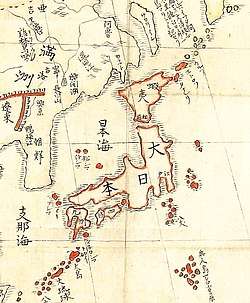Heiji
Heiji (平治) was a Japanese/Chinese era name (年号,, nengō, lit. "year name") after Hōgen and before Eiryaku. This period spanned the years from April 1159 through January 1160.[1] The reigning emperor was Emperor Nijō-tennō (二条天皇).[2]
| History of Japan |
|---|
 |
Change of era
- January 21, 1159 Heiji gannen (平治元年): The new era name was created to mark an event or series of events. The previous era ended and a new one commenced in Hōgen 4, on the 20th day of the 4th month of 1159.[3]
Events of the Heiji era
Notes
- Nussbaum, Louis-Frédéric. (2005). "Heiji" in Japan Encyclopedia, p. 304, p. 304, at Google Books; n.b., Louis-Frédéric is pseudonym of Louis-Frédéric Nussbaum, see Deutsche Nationalbibliothek Authority File.
- Titsingh, Isaac. (1834). Annales des emepereurs du japon, pp. 191-194; Brown, Delmer et al. (1979). Gukanshō, pp. 327-329; Varley, H. Paul. (1980). Jinnō Shōtōki, pp. 208-212.
- Brown, p. 328.
- Titsingh, p. 191.
- Kitagawa, H. (1975), The Tale of the Heike, p. 783.
gollark: You need Mekanism for a lot of stuff. So you are to.
gollark: You need a lot of osmarks metal, yes.
gollark: You put iron ingots and coal into the metallurgic infuser and get enriched iron. Then you run that through and get steel blend, which you smelt into steel. You can decrease coal usage by a factor of 8 by using the enrichment chamber to make compressed coal.
gollark: But it's more efficient and fast. You need a metallurgic infuser and, for coal efficiency, an enrichment chamber.
gollark: Did you make Mekanism steel production? You are to.
References
- Brown, Delmer M. and Ichirō Ishida, eds. (1979). Gukanshō: The Future and the Past. Berkeley: University of California Press. ISBN 978-0-520-03460-0; OCLC 251325323
- Nussbaum, Louis-Frédéric and Käthe Roth. (2005). Japan encyclopedia. Cambridge: Harvard University Press. ISBN 978-0-674-01753-5; OCLC 58053128
- Titsingh, Isaac. (1834). Nihon Odai Ichiran; ou, Annales des empereurs du Japon. Paris: Royal Asiatic Society, Oriental Translation Fund of Great Britain and Ireland. OCLC 5850691
- Varley, H. Paul. (1980). A Chronicle of Gods and Sovereigns: Jinnō Shōtōki of Kitabatake Chikafusa. New York: Columbia University Press. ISBN 9780231049405; OCLC 6042764
External links
- National Diet Library, "The Japanese Calendar" -- historical overview plus illustrative images from library's collection
| Preceded by Hōgen |
Era or nengō Heiji 1159–1160 |
Succeeded by Eiryaku |
This article is issued from Wikipedia. The text is licensed under Creative Commons - Attribution - Sharealike. Additional terms may apply for the media files.